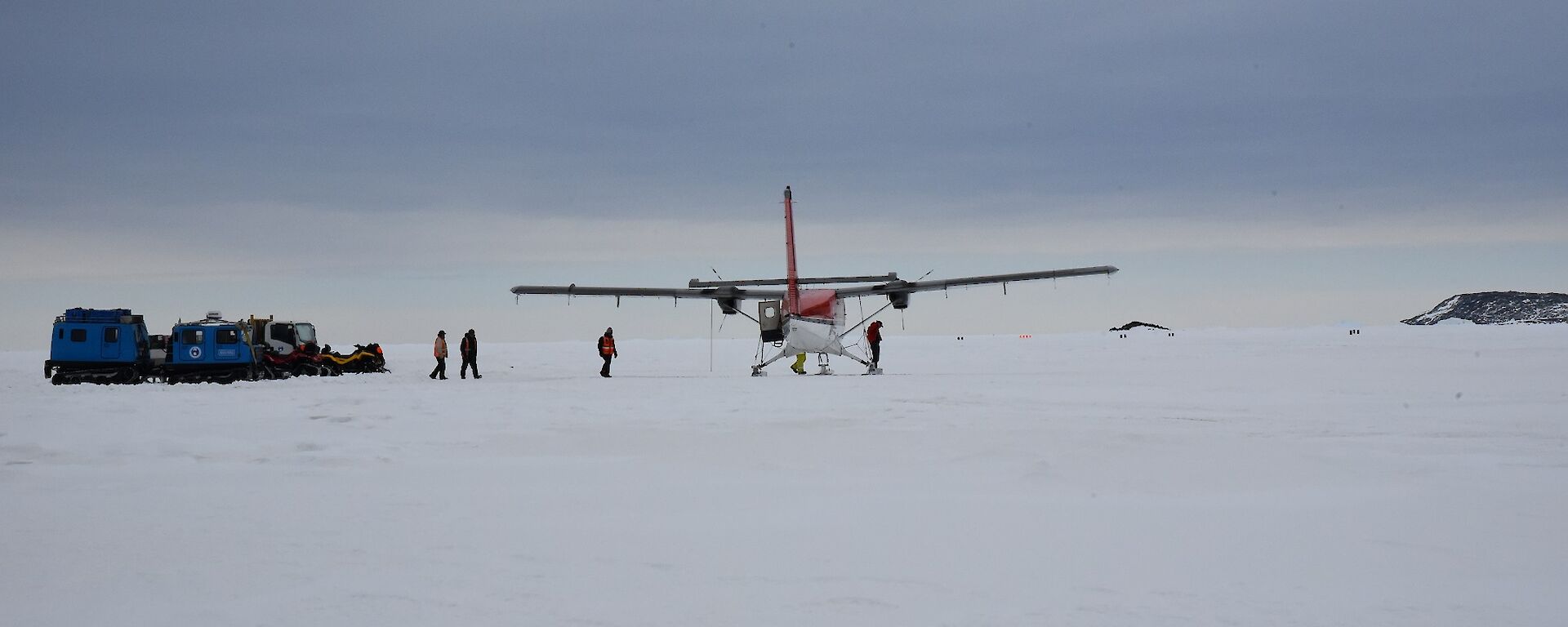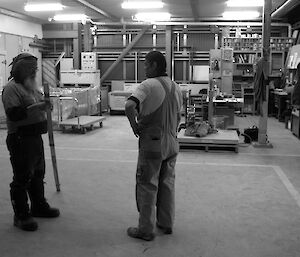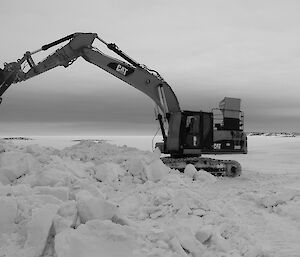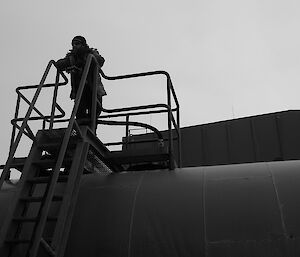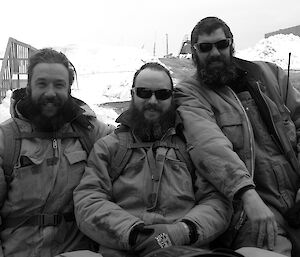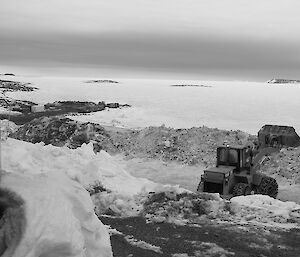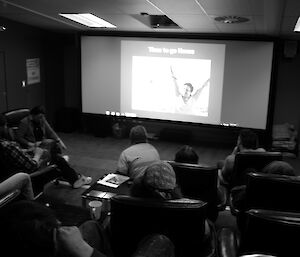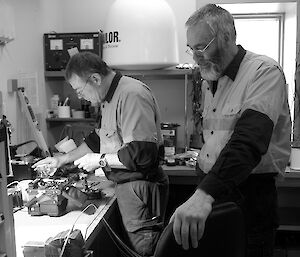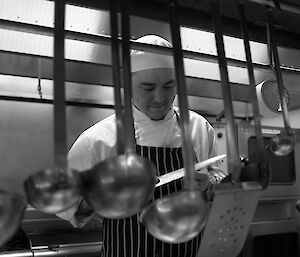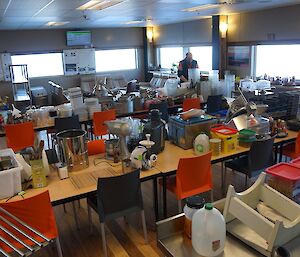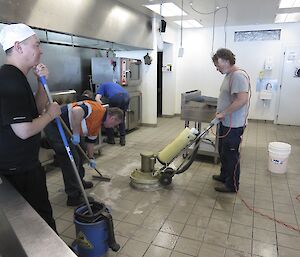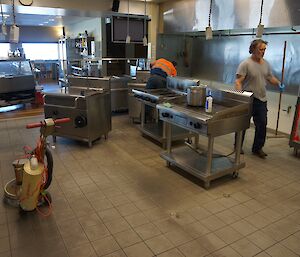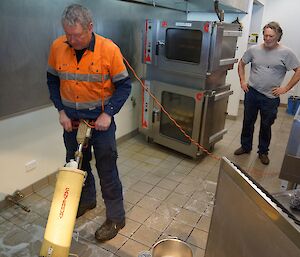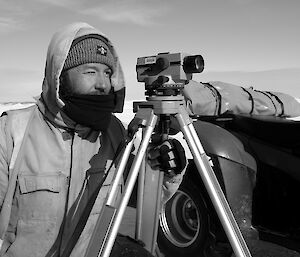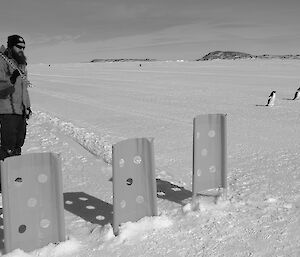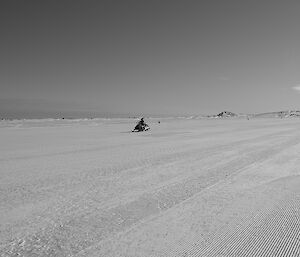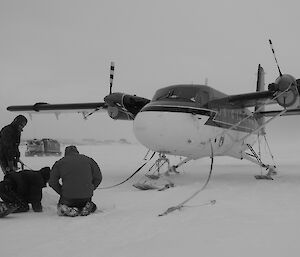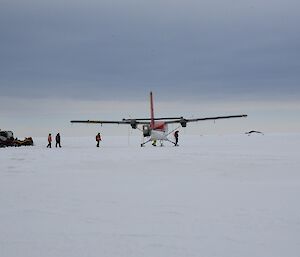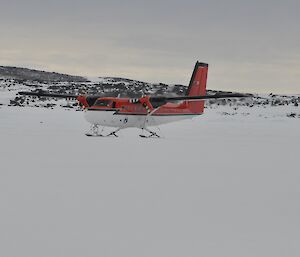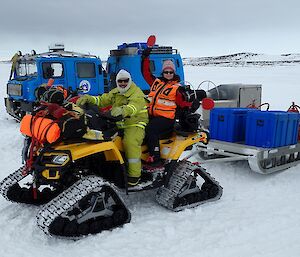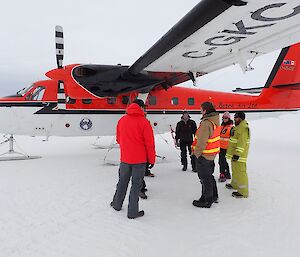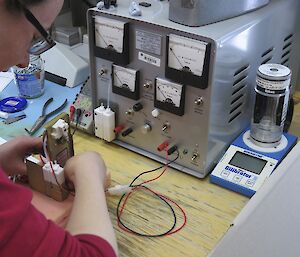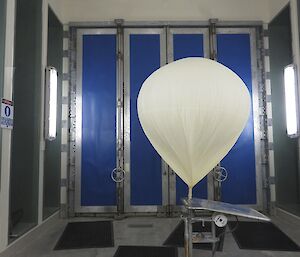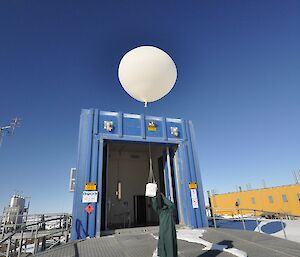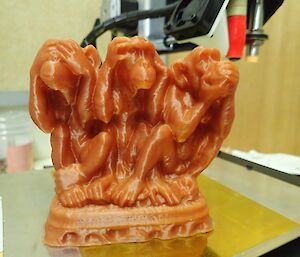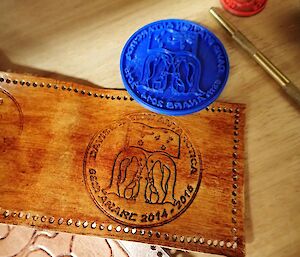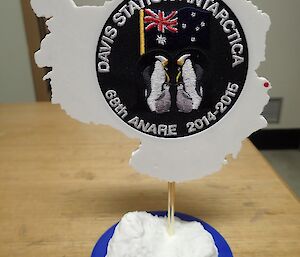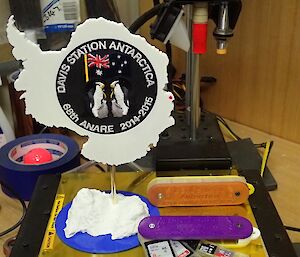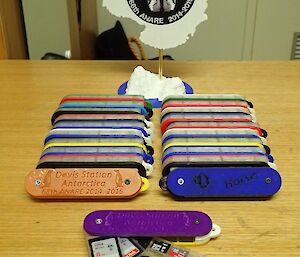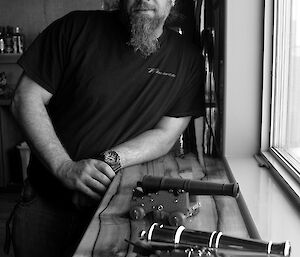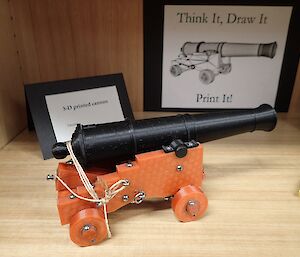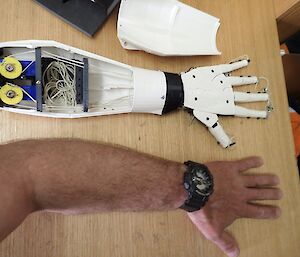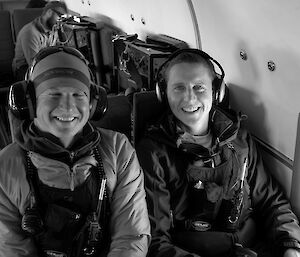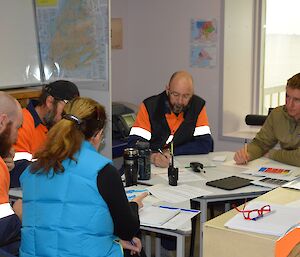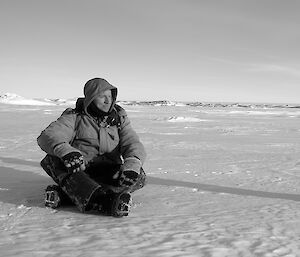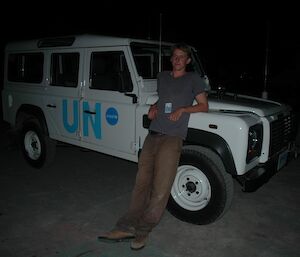In one week (probably), the Aurora Australis will arrive and life will change once again for the 21 wintering expeditioners of the 68th ANARE. Already some changes have taken place this week with the welcome new company of the KBA twin otter crew. As the days tick down to zero, the team on station are busily preparing with a multitude of maintenance, snow clearing, cleaning and administrative rosters running parallel. All have one purpose, to render the station as operationally ready to accommodate and support the objectives of the resupply and ensuing summer program. As you can see, everyone continues to rise to the occasion.
This week at Davis: 6 November 2015
Kitchen overhaul
Since we will shortly have an influx of new people, it was time for our chef Dami to organise some helpers to give the kitchen a thorough clean. Happily ‘volunteering’ to help with the works were Dave B, Mark D, Chris G and Kevin M.
After having cleaned shelves and walls in previous weeks it was on to the floors. Removing almost everything from the area to get good access to the floor for a good scrub was the first task for the team and then it was time to get into the hard work. Initial test patches revealed the best way to get great results, so it was then easy enough for the job to be completed. Luckily for the team the electric scrubber was the ideal way to get the job done.
Everything then had to be reinstalled ready to keep us all well fed. After a solid few hours work, the team had the kitchen looking like brand new again.
Flight of the Twin Otter
Early on Sunday afternoon, as snow clouds gathered beyond station, silence and the seven month period of isolation was punctured by the drone of aircraft engines as a Twin Otter aircraft. The plane, operated by Kenn Borek Air (KBA), passed low over the Vestfold hills, to land on the newly crafted Davis Ski Landing Area (SLA), the product of several weeks of careful planning and hard work by the wintering team.
Russ (senior pilot), his co-pilot Curtis, and flight engineer Karina stepped out of the aircraft to be met by members of the station team including Dr Jan, the mechanical supervisor and architect of the SLA ,Dennis B, and expedition mechanic and aviation first responder Sealy. Not quite a ‘lost tribes’ moment, but almost.
The station population observed the arrival of new faces, with stories to tell and another perspective on life borne from their epic two week journey from Calgary, down through the Americas, across the drake passage to the UK station of Rothera and then on to the South Pole. From Pole to station, the aircraft had been in regular radio contact with Davis station as we conveyed updated weather observations and forecasts whilst monitoring their stoic passage across a very lonely patch of continent.
Their arrival here was the product of a collaboration between KBA and the Australian Antarctic Division, with search and rescue, and logistical support afforded by British (BAS) and American (USAP) programmes, and the Bureau of Meteorology (BOM) in Hobart.
The Canadian flag was flown proudly on station and we've been delighted to host new friends. By doing so, we mark the end of being by ourselves, just us, alone.
Ozone
Although you don’t hear much about the ozone hole in the news at present, it still forms every year and the Bureau of Meteorology (BOM) along with other countries, monitor it as a part of our UN World Meteorological Organisation (WMO) commitments in several different ways. This includes satellite observation from space, Dobson spectrometer readings in Australia and at Macquarie Island, and weekly ozonesonde flights in Australia, and at Davis and Macquarie Island.
Ozone in the upper atmosphere is important as it protects us from the sun’s biologically harmful ultra violet radiation. The ozone hole forms every year during September and October with the return of sunlight over Antarctica. Ozone in the polar vortex is destroyed, forming a thinning of the ozone layer known as the ‘ozone hole’.
The ozonesondes are partially constructed on station by BOM staff with calibration and checks carried out using equipment like the Ozonesonde Test Unit and the Gilibrator bubble maker. The ozonesondes take quite a bit of prep time, 4 hours per sonde over a fortnight plus an hour on the day of release. For this reason we are choosy about the release conditions ensuring that it isn’t too windy so that all that hard work isn’t destroyed by the sonde banging along on the ground after release.
The ozonesonde is attached below a 1200 g balloon – the largest we use within BOM – and a radiosonde is stuck to the outside of the ozone box. The pump inside the ozone box draws in air with a chemical cell measuring the ozone concentration as the sonde moves through the atmosphere. The radiosonde transmits this data with pressure, temperature, wind speed and direction every two seconds during the three hour flight. The balloon carries the sonde to about 30 km high or 10 hPa before bursting and returning to the earth. We record data on the sonde’s return trip as well.
The information we collect here at Davis is entered into the WMO Antarctic Ozone Bulletins.
The ozonesondes are reusable and thus if they are found, we ask that you let BOM know for collection. Expeditioners on the Rauers trip found one such ozonesonde in October, near Woop Woop on the plateau. The ozonesonde was from a release in January 2015 and it is now packed and ready for return on voyage one to the ozone section of BOM in Melbourne. The ozone hole over Antarctica in 2015 will possibly be the greatest depletion observed for several years.
Life in 3D
One of the things which expeditioners face whilst being at an Antarctic station for a long period is working out what hobbies they do at home versus what they can they do at the station.
When I found out I was heading to Davis, I remember thinking what will I do in my down time when I am unable to head out exploring. Since I had begun my hobby of 3D printing a few years ago, I decided to purchase a kit 3D printer to bring down south. This was due to not wanting to bring the larger printer, which I already had. I found the best model available for the budget I had and ordered it hoping it was going to make the cargo cut off date. Two days before cargo cut off for voyage one (V1), I received notification that the package had arrived and it had been packed for Davis.
A few weeks after arriving at Davis as we were getting into the swing of summer, so it was time to start assembling the 3D printer. Two nights later, the printer was ready to test. After a calibration print, it was straight into making a cooling duct for the printer to help with cooling of the prints. A few adjustments later on the printer and in the software, it was time for a bigger print, which was more technical with overhangs and finer detail — this is the real test of the printer and the software. Around six hours later, the three wise monkeys were complete with surprising results: the detail and the overhangs printed far better than expected.
Over the following months, there were many different things made on the printer. One project was a replacement quick shoe for a camera tripod and another project was helping a fellow expeditioner with some of his leather work. After talking about what can be manufactured on a 3D printer one night, I offered to attempt to make some stamps for pressing into soft leather to save carving stamps from metal or timber. After some experimentation to get thickness and size right, the first stamps were produced and put to work on some soft leather. The results were impressive and the time saved over manually producing the stamps was substantial.
V3 arrived bringing with it the upgrades I had been waiting for: a heated build platform, which would allow for the printing of stronger plastics such as ABS. After some testing and adjusting the printer was ready to take on new projects.
Printing gifts
As midwinter was not too far away, it was time to start thinking about a gift. Midwinter has expeditioners – if they choose – give gifts to each other which are normally made on station. I thought, what should I make as my gift? I decided to make something using the 3D printer. After thinking about it for a while, I came up with an outline of Antarctica with the 68th ANARE logo in the centre, which was supported by a stand in the shape of an iceberg. A few nights later, the gift was made, a one off, done on one of the first, if not the first 3D printer in Antarctica (well on the continent, there was one built on Macca a few years ago). With this in mind, what about the other expeditioners? Why not give everyone something made on a 3D printer? What was something that everyone on station could use and how could it be made into a personnel memento to signify their time at Davis over winter?
The answer came one night when looking at ways of storing all of the SD cards which had been brought down for my cameras. A card holder design had just been uploaded onto one of my favourite 3D printing websites and I thought, this could work. A couple of test prints and resizes later to suit the plastic and the printer, and a SD and Micro SD card holder was progressing. Now to make them personal for everyone as a midwinters gift. One cover was redesigned with a ‘Davis Station Antarctica 68th ANARE 2014−2015’ logo and the other cover with a ‘Made in Antarctica’ logo along with the expeditioner’s name.
What else could make these gifts more personal? Making them in their favourite team colours! The hunt was on to find out who supported who so that colours could be put together for these surprises to be handed out at the midwinter dinner. The printer was warmed up and hardly stopped for a little over a month, with each holder taking approximately three and a half hours to print, each then needing final fitting and assembly. Twenty-one SD cardholders later and everyone had a custom, one-off gift.
Thinking of home
As the season went on, I started making components for projects back home, so I have a head start when I get there. One of these projects is the life sized ‘Inmoov’ robot, an open source project out of France. The majority of this project is made using a 3D printer. After a few weeks, the left forearm and hand were printed, now I wait until I get home to add the electronics before it all comes to life.
Over the past year, I have showed the expeditioners here at Davis only a sample of what 3D printing can offer, using an entry level hobbyist printer. Many have been amazed and many have seen the possibilities of what can be achieved with this type of technology, especially in a remote environment such as Antarctica.
Into the future
3D printers have been around for over 20 years, it is only in recent times that many are starting to see the possibilities for manufacturing parts, equipment or anything which cannot be obtained when needed. There are many types of 3D printers that can produce products in many types of materials, some can even use different materials in the one print.
In years to come 3D printers will become a very valuable tool in remote areas such as the Antarctic. This will be to provide parts, tools or even scientific equipment which will see valuable time and money saved by having parts produced on-site and often ready to use long before items can be delivered.
3D printers can bring ideas to life quickly and cost effectively, by use of cheaper materials and concept proving before more expensive methods of manufacture are sought. It is exciting times ahead with more and more companies employing this technology in the pursuit of efficiency and cost saving. I can’t wait to see how this is adopted in the future, especially for places such as this.
Dennis B
[Ed. And we cannot wait to see how you continue to apply this technology which seems made for Antarctica. Many thanks Dennis!]
Doc’s Dozen
James Moloney, Davis Station Leader, and Davis (sub) station news editor
James, is this your first trip to Antarctica? What brings you here?
My first extended trip, yes. As part of the recruitment process, I undertook a round trip voyage during resupply to Davis and Casey in 2014. I was very pleased to be returning here.
What is it like being a station leader here?
Like a complicated algorithm…
A support role that is multi-faceted: working to maintain the safety and welfare of the station community and to work with the management team and every expeditioner to ensure that program objectives are met in a way that keeps with the Division’s policies and procedures. So there’s quite a bit of admin involved in that but thankfully there’s also lots of opportunities to be another pair of hands in support of tasks undertaken by the work groups, so I learn a lot.
If not a station leader what job would you do (here and in the real world)?
Here, given what happened to the crowbar and the hydraulic hose I was put ‘in charge’ of, I’m pretty sure I failed my dieso apprenticeship and became eligible for an arts fellowship all in one glorious moment. As for the ‘real world’: something that involves field work and research, interesting places, dedicated individuals. Hmmm, and helicopters.
What has been your best gig in a real world job James?
In being officer-in-charge of a UN WHO field office in Pakistan I had the pleasure to work with a great bunch of people delivering field based projects in an operating environment that had its own challenges. A few parallels to being here really, save for the 70 odd degree difference in temperature.
Best experience in Antarctica?
That will be seeing everyone return safely home to Australia after a job well done. In the meantime, the highlight has been observing the devotion and solidarity exhibited on station, on the Aurora Australis and in Kingston as the organisation responded to a medical emergency in March with a good outcome in the end.
Doc: Yes. It was team building at its best.
What do you love about Antarctica?
Everything. It demands of us our better selves if we’re to stay functional, happy and safe together, combined with its sheer beauty and otherness. It imbues you with a perspective that I like.
James, who inspires you?
Anyone who tries to do their job to the best of their ability.
What have you learned living in a small community?
Love all the people.
If you were a car, what car would you be James?
I didn’t think Polar Med did the psych testing of expeditioners, Jan…
Doc: Let me see… perhaps a garish coloured Datsun 240Z?
[Ed. Garish? Since when was a lime/canary yellow mix garish?]
What is the ‘must have’ item that you packed for Antarctica (and what did you really regret not bringing, plus what proved to be the most useless item you brought along?)
Quiet comfort, noise cancelling headphones. I won’t do product endorsement here but there’s really only one company that does them properly and they know who they are. Materially, we want for nothing down here. The guys keep telling me the polar bear repellent is useless but I keep using it and it’s doing a hell of a job.
What is in store when you return to home?
Being good to family and friends, re-negotiating a time share arrangement with the colony of bats occupying my house, and then study.
Well James, thank you for your thoughts and insights but especially for all the many hours that you and the rest of the Davis station news editorial staff have devoted to getting the news out there to all our thousands of readers week after week. I would like to encourage you in your new field of endeavour and hope the studies go well, and just remember, if you get stuck you can always phone a friend.

